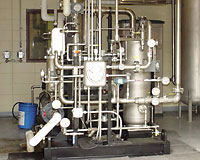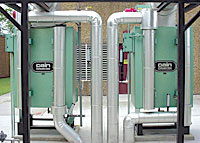 BioCycle March 2009, Vol. 50, No. 3, p. 41
BioCycle March 2009, Vol. 50, No. 3, p. 41
Wastewater plant in Sheboygan, Wisconsin succeeds with project to cut energy costs while increasing energy production in its anaerobic digesters.
Diane Greer
WATER and wastewater treatment plants (WWTP) are significant consumers of energy. The U.S. Environmental Protection Agency estimates the industry uses the equivalent of 56 billion kilowatt hours (kWh) of electricity, representing three percent of the nation’s energy consumption, and is responsible for creating 45 million tons of greenhouse gas emissions each year. Energy intensive processes, such as solids handling, aeration and pumping, account for the bulk of energy expenses and can represent 25 to 30 percent of WWTP operating costs.
The Sheboygan Regional Wastewater Treatment Plant (SWWTP) in Sheboygan, Wisconsin treats an average of 11.8 million gallons of wastewater a day. Between 2002 and 2008, SWWTP saw natural gas prices increase by 108 percent and electricity rates rise by 72 percent. “Energy rates were increasing at a greater rate than inflation,” says Dale Doerr, the plant’s superintendent.
Doerr created a two-pronged strategy to reduce the facility’s dependence on purchased energy. The first was energy reduction – a priority when replacing equipment and designing changes. “If we could install more energy efficient equipment and reduce energy consumption that is the direction we took,” he says. Second was to increase biogas production in the facility’s anaerobic digesters. “We now have enough gas to run everything, heat the plant and use minimal natural gas,” Doerr adds.

OPTING FOR MICROTURBINES
Steps toward cutting energy costs began in 2002, when Sheboygan joined with Wisconsin Focus on Energy and Alliant Energy, the local power utility, to conduct a feasibility study looking at recovering heat from hot water discharged by an Alliant power plant located adjacent to SWWTP. The power plant discharged 250,000 gallons of hot water per minute into Lake Michigan – water that could warm Sheboygan’s digesters.
At that time, the facility’s anaerobic digesters, used to treat wastewater solids, produced 200,000 cubic feet of biogas per day (cfd). About 75 percent of the biogas was used to fuel three boilers heating the digesters and to drive an engine running an influent pump. The facility flared the remaining biogas, approximately 50,000 cfd. The boilers were old and in need of replacement. One had failed after 24 years of service. “The two remaining weren’t far behind,” Doerr says.

But while the project to use the discharged water as a heat source looked promising on paper, it didn’t work economically. “Alliant Energy wanted to charge us for the hot water they were dumping in the lake and we were going to pay the capital costs,” Doerr says. “We did not think that was feasible to pay a fee for the water they were dumping anyway.”
The study also suggested that Sheboygan look at cogeneration to use the excess biogas flared at the facility. Cogeneration, also known as combined heat and power, would produce power for the facility while heat recovered from electrical generation would displace purchased natural gas for thermal requirements. Cogeneration systems using a reciprocating engine or microturbines to generate electricity were considered, and SWWTP ultimately decided that four 30-kilowatt (kW) microturbines were the way to go. “With microturbines if you only have enough gas to run three turbines, then three would run,” Doerr explains. “But with a reciprocating engine if you did not have enough gas for the engine to run you would not put any kilowatts out.”
Microturbines offer several other advantages over reciprocating engines, says Dave Broihahn, vice president of Unison Solutions in Dubuque, Iowa, the company that provided project management services for the installation of the cogeneration system. “Emissions are cleaner, maintenance is cheaper and noise and vibration are less with microturbines. Utility integration is also easier.”
But the project hit a snag when Doerr uncovered problems using biogas generated from WWTPs in microturbines. Siloxanes, chemicals used extensively in personal care products like cosmetics and shampoos, volatilize when entering the digester via the sludge stream and get into the digester gas. “When siloxanes get into microturbines turning at 90,000 rpm, they dry out and become like sand and just tear-up the microturbine,” he explains. “So we backed off. We were not going to invest $500,000 to put in microturbines if this is an issue.”

A “SWEET DEAL”
Then Alliant Energy came forward with an innovative deal to move the project forward. Several years earlier, Alliant had entered into a distributorship agreement with Capstone Turbine Corp., which required Alliant to purchase a set number of microturbines. In 2003, Allen Rutkowski joined Alliant as its manager of technical sales support and was tasked with utilizing the microturbine inventory by identifying customers who could use the equipment or placing the equipment at Alliant projects.
“We started finding that biogas applications were much stronger financially than natural gas fired installations,” Rutkowski says. “The price of electricity in the Midwest was too low to support natural gas fueled Capstone applications. The idea of using biogas, which is a free fuel, makes a lot more sense economically.”
Alliant started negotiations to supply 10 30-kW Capstone microturbines to SWWTP. At the same time, Ingersoll Rand also proposed a solution. “It became a bidding war,” Doerr says. “We ended up with a real sweet deal out of this and it has been a real success story.”
Under the terms of the deal, Alliant installed and owns 10 Capstone microturbines, the gas treatment gear for removing the siloxanes and the gas compression equipment. SWWTP paid for and owns the heat recovery system. “Sheboygan provides the gas for the microturbines at no charge and we provide the heat from the microturbines back to Sheboygan at no charge,” Rutkowski explains. Electricity generated by the turbines is fed into the grid and sold back to Sheboygan at the normal tariff rates. After six years, Sheyboygan has an option to purchase the turbines for $100,000.
Project costs for the cogeneration system were $1.2 million. SWWTP paid $200,000 for the heat recovery equipment. Alliant paid the remaining costs. The project also received a $20,000 Wisconsin Focus on Energy grant. “It’s an interesting deal for them,” Rutkowski says. “They get to use the biogas and get the heat for free and we get to continue to sell them electricity.”
GAS TREATMENT
Unison Solutions provided overall project management for the construction and also designed and manufactured the gas treatment system for the biogas. The treatment equipment reduces the moisture level of the gas and eliminates the siloxanes, which are removed using carbon-based filtration media, explains Jan Scott, Unison’s president.
The gas is compressed to 100 psi, the pressure required by the microturbines, by a gas compressor. All the treatment and compression equipment is skid mounted except for two filtration vessels. Unison designed and installed the real time monitoring for the system. “Our PLC [programmable logic controller] program is internal to our gas conditioning skid and also monitors the microturbines,” Broihahn explains.
Two Cain heat exchangers were installed to recover and utilize the heat from the microturbine’s exhaust. The recovered heat maintains the digesters at the proper temperature and provides heat to SWWTP’s facilities during the winter. The project also replaced the three antiquated boilers used to heat sludge with two 3.8 million BTU fire tube boilers. Excess heat generated by the boilers is also used to heat buildings at the plant. Space heating provided by the microturbines and boilers slashed natural gas consumption by 78 percent.
BOOSTING BIOGAS PRODUCTION
Doerr optimized biogas production by adding high-strength wastes to SWWTP’s anaerobic digesters. “We were already receiving these wastes at what we call the wet end where they had to go through the entire treatment process,” he says. Treatment costs for industries producing these wastes were high due to BOD, phosphorus and solids concentrations in the waste.
The facility decided to put some of the high-strength wastes directly into one of the digesters, without going through the wet end. Cheese processing wastes were selected for the first test. “Within a couple of hours we saw the gas production just going out of sight,” Doerr says. After repeating the process a few times, his team decided to see what other wastes would boost biogas production.
“We started looking at the numbers and took the wastes that had the high BODs and low solids numbers,” Doerr says. Disposal costs for industries providing the waste were substantially decreased. “Right now we charge them about $30 per thousand gallons. Previously they could pay upward of $120 per thousand gallons.”
Feeding the additional wastes to the digesters required minor operational modifications. The waste was dumped into an old, unused digester tank at the facility and then pumped into the digesters for processing. But the solids in the holding tank tended to settle, causing pumping problems. To remedy the situation, a pump system previously used to empty the old digester tank was configured to recirculate the waste, mixing it for about one hour per day to prevent settling. “That eliminated the plugging that happened with this thick sludge,” he explains.
SYSTEM PAYBACK
Adding high-strength wastes to the digesters increased biogas production by 90 percent. In 2008, cogeneration in conjunction with increased biogas production produced 1.7 million kWh of electricity, or 4,509 kWh per day. Heat recovered by the microturbines totaled 65,602 therms, or 18 million BTUs per day, valued at $61,686 a year. Thermal heat recovery reduced natural gas bills from $100,000 in 2005 to $24,000 in 2008.
Payback for the entire project is estimated at less than six years. The city recovered its investment in the heat recovery equipment in the first two years. SWWTP is also receiving revenue from selling the renewable energy certificates (RECs) created by the project. RECs were valued at $3,000 in 2006, $6,000 in 2007 and $5,100 in 2008.
Prior to completing the cogeneration project in early 2006, SWWTP embarked on a number of projects to reduce electricity consumption. Pump station upgrades replaced eddy-current drives with more efficient variable frequency drives (VFD), yielding 20 to 32 percent reductions in electricity usage at the stations. Replacing aeration blowers at the treatment plant decreased electrical consumption by 20 percent, saving over $26,000 in 2008.
Total energy savings from all the projects, including the cogeneration plant, boiler replacement and energy efficiency upgrades/replacement, saved Sheboygan $165,439 in 2008. Reducing consumption of outside energy sources has permitted the facility’s energy costs to remain flat, despite increasing prices. Energy costs are now less than 11 percent of the operating budget.
Rutkowski is seeing more WWTPs generating electricity from biogas. “There is more awareness now of the capability based on Dale’s success,” he says. “He has had many opportunities to talk about his project and the word is getting out.”
Doerr is considering adding more microturbines to the facility. But due to budget constraints, expansion of the cogeneration capacity will have to wait until 2012. “We are looking at the possibility of adding them if any of the stimulus money comes our way,” he says. “We definitely would do it, but it’s a budgeting issue.”
Diane Greer is a Contributing Editor to BioCycle.
March 24, 2009 | General










